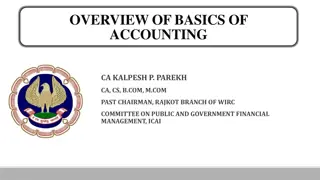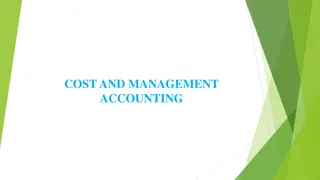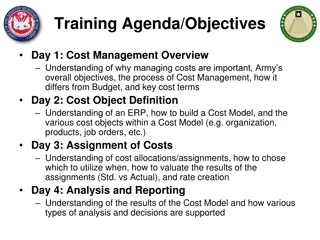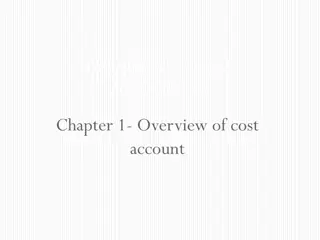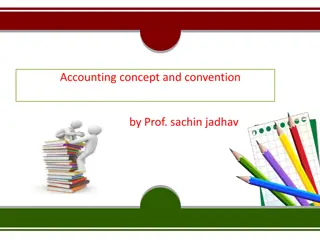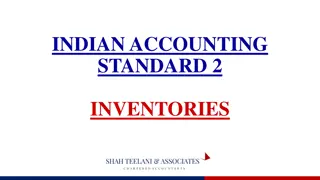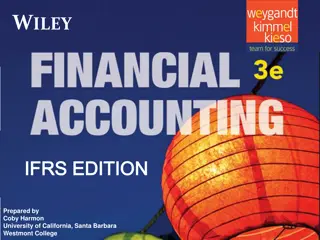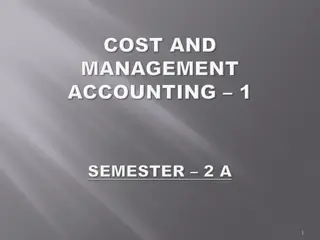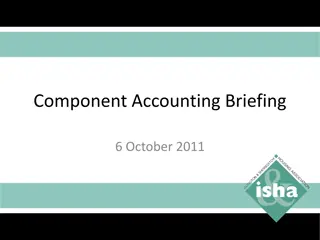Overview of Cost Accounting and Its Objectives
Cost accounting is the application of costing principles and techniques to control costs and ascertain profitability. It helps in decision-making, setting prices, identifying wastage sources, and improving efficiency. While it has advantages like aiding in decision-making and preventing fraud, it also has drawbacks such as being expensive and involving excessive paperwork.
Download Presentation

Please find below an Image/Link to download the presentation.
The content on the website is provided AS IS for your information and personal use only. It may not be sold, licensed, or shared on other websites without obtaining consent from the author.If you encounter any issues during the download, it is possible that the publisher has removed the file from their server.
You are allowed to download the files provided on this website for personal or commercial use, subject to the condition that they are used lawfully. All files are the property of their respective owners.
The content on the website is provided AS IS for your information and personal use only. It may not be sold, licensed, or shared on other websites without obtaining consent from the author.
E N D
Presentation Transcript
Definition According to ICMA London, cost accounting is the application of costing and cost accounting principles ,methods and techniques to the science, art and practice of cost control and ascertainment of profitability.it includes the presentation of information for the purpose of decision making.
Objectives of cost accounting To find out the total cost and cost per unit To disclose the proportion of different elements in the total cost To provide necessary data for fixing the selling price To ascertain the profitability of each product To identify the sources of wastages and losses To help in the preparation of budgets and its implementation To formulate incentive bonus plans and implement them To exercise effective control on the idle times of men and machines
Advantages of cost accounting Helps in decision making Helps in fixing prices Formulation of future plans Avoidance of wastage Highlights causes Reward to efficiency Prevention of fraud Improvement in profitability
Demerits of cost accounting It is unnecessary It is expensive It is a failure Too much of paper work Restricted applicability
Elements of cost Total cost Material Labour other expenses Direct Indirect Direct Indirect Direct Indirect overheads
Classification of cost Classification according to nature element Classification according to function Classification according to variability a)Fixed cost b)variable cost c)semi-variable cost Classification according to normality a)Normal cost b)Abnormal cost Classification according to controllability a)controllable cost b)uncontrollable cost
Classification by time a)Historical cost b)Pre determined cost Classification according to managerial decisions a)Marginal cost b)Differential cost c)Imputed cost d)Replacement cost e)opportunity cost f)sunk cost Classification according to capital and revenue a)capital costs b)Revenue costs Classification by association with products a)products cost b)period cost
Methods of costing Job costing Contract costing Batch costing Process costing Unit costing Operating costing Multiple costing
Techniques of costing Historical costing Direct costing Absorption costing Uniform costing Marginal costing Standard costing
Cost unit A cost unit refers to a unit of product, service or time in relation to which costs may be ascertained or expressed. Cost Centre A cost Centre is a location ,person or item of equipment for which cost may be ascertained and used for the purpose of cost control
Cost sheet Cost sheet is a statement.it provides information regarding the various elements of cost incurred in production.it discloses the total cost and the cost per unit of products manufactured during the given period.
Types of cost Centre Production cost Centre Service cost Centre Personal cost Centre Impersonal cost Centre Operation cost Centre Process cost Centre Profit Centre
Material control Material control is defined as a systematic control over purchasing ,storage and consumption of materials,so as to maintain a regular supply of materials and avoiding at the same time overstocking
Objectives of material control To make available the right type of materials at the right time To ensure effective utilization of material To prevent over stocking of materials and consequent locking of materials To procure appropriately raw materials at reasonable price To prevent losses during storage of materials To supply information to the management
Pricing issues of material Pricing of materials may change from time to time. Materials are usually acquired by several deliveries at different prices. Actual costs can then take on several different values. Therefore, the materials pricing system adopted should be the simplest and the most effective one.
Methods of stock valuation First-in-first-out(FIFO) Last-in-first-out(LIFO) Weight average cost (WAVCO) Specific identification/unit cost method
First-in-first-out This method assumes that the first stock to be received is the first to be sold. The cost of materials used is based on the oldest prices. The closing stock is valued at the most recent prices.
Last-in-first-out(LIFO) This method assumes that the last stock to be received is the first to be sold. Therefore, the cost of materials used is based on the most recent prices. The closing stock is valued at the oldest prices.
Weight average cost (WAVCO) This method assumes that the cost of materials used and closing stock are valued at the weighted average cost.
Specific identification/unit cost method This method assumes that each item of the stock has its own identity. The costs of materials used and closing stock are determined by associating the units of stock with their specificunit cost.
Economic Order Quantity(EOQ) EOQ is the order quantity that minimizes total inventory carrying costs and ordering costs. Ordering costs are costs that are incurred on obtaining additional inventories. They include costs incurred on communicating the order, transportation cost, etc. Carrying costs represent the costs incurred on holding inventory in hand. They include the opportunity cost of money held up in inventories, storage costs, spoilage costs, etc. 2*O*Q EOQ= C Where EOQ = Economic Order Quantity O= order cost perorder Q = Annual quantity required in units C =Carrying cost per unit perannum
Example The annual consumption of a part X is 5000 units. The procurement cost per order is $10 and the cost per unit is $0.5. The storage and carrying cost is 10% of the material unit cost. Required: Calculate the EOQ
Solution O= $10 Q=5000, C=$0.5*10% 2 OQ C EOQ = 2 * 5000*10 0.5*10% EOQ= = 1414units
Levelsetting It is to determine the correct or most optimal stock level so as to avoid overstocking or under- stocking of materials. These levels are known as the Maximum, Minimum and Re-order levels.
Re-orderlevel The level of stock of material at which a new order for the material should be placed. The formula: Re-orderlevel = (Maximum usage * Maximum lead time)
Maximumlevel The maximum stock level is highest level of stock planned to be held. Any amount above the maximum level will be considered as excessive stock. The formula: Max level = re-order level + Re-order quantity(EOQ) Min anticipated usage in Minimumlead
Minimum level/Safetystock The minimum level is that level of stock that provides a safety buffer in the event of increased demand or reduced receipt of stock caused by the lengthening of lead time. The stock level should not be allowed to fall below the safety stock. Min level= Re-order level Avg. usage in avg. lead time
EXAMPLE Average usage 1000 units per day 800 units Minimum usage per day 1350 units per day Maximum usage Order 9000units Quantity Delivery reliably expected at the beginning of the fourthday. Required: Find the three controllevels.
Re-orderlevel = (Maximum consumption * Maximum re-order period) = 1350 units*4 = 5400units Minimumlevel = Re-order level Average usage in average lead time = 5400 units (800 units *4) = 2200units Maximumlevel = re-order level + EOQ Minimum anticipated usage in Minimumlead = 5400 units +9000 units (800 units*4) = 11200units





